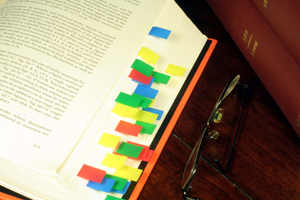Format your research paper assignments using Turabian style

citations. Better brush up on your knowledge
of Turabian formatting today!
Do the terms Chicago Manual of Style, Harvard, Modern Language Association (MLA), and American Psychological Association (APA) make your head spin when you're citing references for a research paper? Well, we have another style guide for you to add to the list: the Turabian style guide, called A Manual for Writers of Term Papers, Theses, and Dissertations. This guide was authored by Kate Turabian, who worked as dissertation secretary at the University of Chicago for many years before retiring in 1958.1
Turabian is a close relative of the Chicago Manual
The good news is that Turabian formatting is based on the Chicago Manual of Style and does not radically differ from it. As you can see from the footnote below, the citation style is similar to Chicago style, including the italicized title and placement of the publication year at the end of the reference.
An important feature of Turabian style is that references can be placed either in the text of your research paper (as in MLA) or as footnotes/endnotes. Whatever style you choose, use that style consistently and always include a bibliography.
Differences to watch out for
Turabian formatting differs slightly from the Chicago Manual of Style when dealing with in-text citations, footnotes/endnotes, and bibliographies.
Books
The format for footnotes/endnotes is as follows (it is also shown below):
Kate L. Turabian, A Manual for Writers of Research Papers, Theses, and Dissertations: Chicago Style for Students and Researchers, 7th ed. (Chicago: University of Chicago Press, 2007), xiii.
Here is the same citation, as it would appear in-text:
Kate Turabian was a long-time dissertation secretary (Turabian 2007, xiii).
Here is the same reference, written for the bibliography:
Turabian, Kate L. A Manual for Writers of Term Research, Theses, and Dissertations: Chicago Style for Students and Researchers. 7th ed. Chicago: University of Chicago Press, 2007.
Note: There is no comma after the author's name, no brackets are used, and no page number is specified because, obviously, a source listed in the bibliography is not the same as a citation.
Journal Articles
Have you used journal articles for your research paper? Then your footnote/endnote should look like this:
Holly Christmas and Sunny Easter, "Holidays, Traditions, and Celebrations: An Anthropological Study of Cross-Cultural Determinism," Journal of Applied Human Behavior 18, no. 5 (May 1999): 637.
Your in-text citation should look like this:
(Christmas and Easter 1999, 637)
And your bibliographic entry should look like this:
Christmas, Holly and Easter, Sunny. "Holidays, Traditions, and Celebrations: An Anthropological Study of Cross-Cultural Determinism." Journal of Applied Human Behavior 18, no. 5 (May 1999): 637-59.
Clear as mud? Did you note the reversed name order, the periods instead of commas, and the complete page range used in the bibliographic reference? If not, we encourage you to have a second look.
Website
Since online resources are so often used in academic papers these days, here is an example of a website citation for a footnote/endnote:
René R. Gadacz, "Igloo," The Canadian Encyclopedia, https://www.thecanadianencyclopedia.com (accessed July 5, 2009).
For an in-text citation:
(Gadacz)
And for the bibliography:
Gadacz, René R. "Igloo." The Canadian Encyclopedia. https://www.thecanadianencyclopedia.com (accessed July 5, 2009).
Information abounds on the Turabian style
There are innumerable sources of information available to assist you with Turabian style. We have created a detailed Turabian bibliography to show you precisely how to cite an array of resources using Turabian style.
Formatting is your friend
Remember that style guides are designed to help you; they were developed to make academic papers consistent and easy to understand. If you follow these guidelines, the result will be a professional and flawless document. When you're in doubt, our essay editors will be delighted to review your work, and provide you with a comprehensive style check.
1Kate L. Turabian, A Manual for Writers of Research Papers, Theses, and Dissertations: Chicago Style for Students and Researchers, 7th ed. (Chicago: University of Chicago Press, 2007), xiii.










